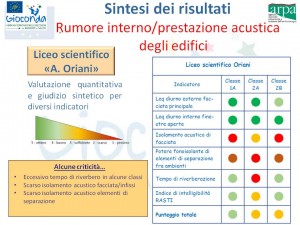It is a great wealth of information that emerges from the data processing of air and acoustic pollution monitoring data carried out in the four locations of GIOCONDA: Ravenna, Taranto, Naples, Valdarno Inferiore, as well as the questionnaires on the perception of environmental and health risk filled out by the boys and the girls in the last school year.
While the work of ARPA Emilia Romagna proceeds to coordinate the processing of air and noise monitoring results collected in other locations of the project, Ravenna data are now available to local administrators in Ravenna and Province and to all stakeholders on territory (data relating to “E. Mattei” Middle School, data relating to “A.Oriani” High School).
ARPA Ravenna then prepared a version dedicated to teachers and students, available here.
Patrizia Lucialli, responsible for coordinating all GIOCONDA environmental monitoring, and Federica Manzoli, who takes care of the project’s educational and communicative activities for the CNR Clinical Physiology Institute, premiered the data to stakeholders in the area. Guido Guerrieri, Councilor for the Environment, Luana Gasparini of Environmental Education Center of the Municipality and coordinator of local actions, Giuliano Silvi of the Department of Public Health, the leaders of the participating schools: Gianluca Dradi for Oriani High Scientific School and Giancarlo Frassineti for Enrico Mattei 1st grade Secondary School of Marina di Ravenna, Ouidad Baccali, Councilor for Education, Enrico Liverani, Councilor for Public Works and Mobility, Caterina Porcu of the European Policy Bureau of the Municipality.
The research shows a rather good situation: from the point of view of atmospheric pollutants monitored inside and outside the classrooms in the school year 2014/15, there are no deviations from what the air quality monitoring network observes and the legal limits are not exceeded. This means the presence of fine powders (PM10 and PM2.5) and other pollutants such as benzene and nitrogen dioxide below the limits of law. However, this does not mean that the issue of pollution that affects the health of citizens does not exist: in the polluted subsoil of the Padana plain, any action to reduce the risk of exposure must be promoted and put into practice by all citizens.
There is a difference in the noise monitoring situation, which outside the schools exceeds the statutory limits and in some classrooms presents a strong criticism due to poor sound isolation and a consequent excessive reverberation time, ie the echo effect that prevents teachers and students from communicating to the best.
The results of the perception of environmental risk related to their health show as girls and boys in the two schools – for a total of 152 respondents aged 11 to 17 – clearly identify air pollution as the main problem, while noise, despite being recognized as a problematic item, does not raise any concerns.
Knowledge and fear travel together: at a knowledge value that is “sufficient” in terms of the damage that air pollution causes to their health, there is a fear of the damage that air mediates, confirming a generally good perception of the environment where they live.
Health damage caused by noise pollution scares less as absolute, while for all the risks related to the environment and health, adults seem to the biggest concerns comparted to our young respondents and their peers.
Interestingly, to the question: “Why you think you do not have to commit yourself”, responsibilities are given first and foremost entrusted to the institutions. “The Mayor must deal with these things, not me” is the most voted option; the second and third places are “I think there are more urgent issues than pollution” and “my contribution would still be too small”.
To clarify how everyone can make an important contribution, instead, GIOCONDA activities will carry on. Young people count in decisions on health and the environment.

